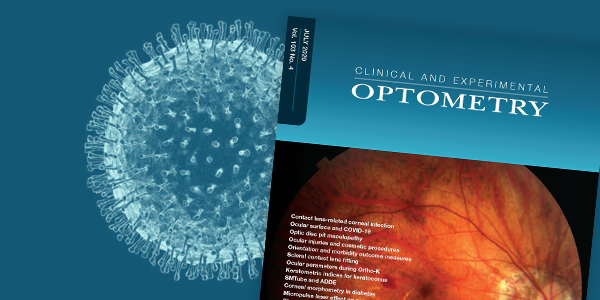1:30min

By Helen Carter
Journalist
A review of evidence, published in July’s Clinical and Experimental Optometry, indicates the eye is an unlikely site for SARS‐CoV‐2 infection, suggesting coronaviruses are unlikely to bind to ocular surface cells to initiate infection.
However, reviewers found it was possible for the virus to appear at the ocular surface although “ocular manifestations such as conjunctivitis and presence of SARS‐CoV‐2 in tears had so far only been found rarely and primarily in people with confirmed, symptomatic COVID‐19.”
Their findings are based on a literature search conducted on April 15, 2020, returning 287 results.
The reviewers included leading optometrists from the US, UK and Canada and from Australia, lead author, medical microbiologist and Professor and Director of Research in the School of Optometry and Vision Science at the University of New South Wales, Professor Mark Willcox.
They said the ocular surface had been suggested as a site of infection with Coronavirus-2 (SARS-CoV-2) responsible for COVID-19 so they examined evidence for this hypothesis and evaluated evidence for the ocular surface as a route of infection.
Their open access paper said: ‘The conclusions shared in this review provide evidence and reassurance that the eye itself is unlikely to be a major route for transmission, although this does not change the level of care required in clinical situations at present, given the potential to transmit the virus through airborne droplets and direct contact from the mouth and nose.
‘Additionally, hypotheses that the virus could travel from the nasopharynx or through the conjunctival capillaries to the ocular surface during infection have yet to be proven.
‘Conjunctivitis and isolation of the virus from the ocular surface occur only rarely, and overwhelmingly in patients with confirmed COVID‐19.’
Consider all kerato conjunctivitis as potential COVID-19
But they said all cases of kerato conjunctivitis, especially those with associated upper respiratory tract symptoms, however mild, should be considered as potential COVID‐19 cases.
‘While rare that kerato conjunctivitis presents as the first sign of COVID‐19, eye‐care practitioners must bear this in mind when triaging patients and considering how best to review, potentially examine, or refer, a patient in this situation,’ they wrote.
They said scrupulous contact lens hygiene practices should continue to be advocated, along with use of correct wear, care, cleaning and replacement of lenses and lens cases, given the need for contact lens wearers to touch their face and eyes on application and removal.

Professor Mark Willcox, above, co-authored the paper with Karen Walsh and Professor Lyndon Jones from the University of Waterloo, Professor Jason Nichols from the University of Alabama and Professor Philip Morgan from the University of Manchester
Why the eye is an unlikely site for COVID-19 initiation
Severe Acute Respiratory Syndrome Coronavirus‐2 (SARS‐CoV‐2), responsible for the COVID‐19 pandemic, is transmitted by person‐to‐person contact, via airborne droplets, or through contact with contaminated surfaces. SARS‐CoV‐2 binds to angiotensin converting enzyme‐2 (ACE2) to facilitate infection in humans, the reviewers wrote.
‘There is preliminary evidence for ACE2 expression on corneal and conjunctival cells, but most of the other receptors to which coronaviruses bind appear to be found under epithelia of the ocular surface,’ they wrote.
‘Evidence from animal studies is limited, with a single study suggesting viral particles on the eye can travel to the lung, resulting in very mild infection.
‘The ocular surface does possess the ubiquitous viral receptor heparan sulfate, which can facilitate initial viral attachment. However, this is not sufficient for coronavirus infection. Furthermore, lactoferrin that is present in high concentrations in tears prevents viral attachment to heparan sulfate.’
A week after their literature search, doctors from an Italian eye clinic published a report claiming conjunctivitis could be the only presenting sign and symptom of COVID-19. They reported five cases of patients referred by GPs because acute conjunctivitis was not improving after several days.
The non-remitting conjunctivitis was the sole presenting sign and symptom of COVID-19. The Italians wanted to emphasize that atypical clinical presentations of COVID-19 could occur, a high level of suspicion should be maintained and ocular involvement and transmission of SARS-CoV-2 should never be overlooked.
They said “conjunctival mucosae are susceptible to respiratory viruses and remain an important point of entry,” but Professor Willcox said that despite this report, their conclusion stood.
Conjunctivitis rare
‘Whilst there may be cases of conjunctivitis in people with COVID-19, in the absence of detecting the SARS-CoV-2 virus we can’t be sure they are connected,’ Professor Willcox told Optometry Australia.
‘One of the largest studies looking at signs and symptoms has since been conducted in the UK and suggests conjunctivitis is almost never seen in cases of COVID-19 so I think our conclusion stands.’
The preprint (not peer-reviewed) article studying 16,749 hospitalised UK patients with COVID-19 is the largest detailed description of COVID-19 in Europe.
Read also in July CXO, Evaluation of the Slit Lamp Shield to reduce droplet exposure and check out Optometry Australia’s online resources on coronavirus which include updated advice on “Should I be wearing a mask?”

Preventing COVID-19 in 25 minutes
Optometrists, for a complete guide to infection control during the COVID-19 pandemic covering how to protect you, your patients and staff, the best 25 minutes you can spend is watching this new video from Optometry Australia’s Chief Clinical Officer, optometrist Luke Arundel.
Luke delivered the online presentation at Optometry Virtually Connected recently. If you missed it, get on board and even if you saw it, it’s definitely worth watching again.

Tagged as: Clinical & Experimental Optometry (CXO), COVID-19, Eye examinations, Patient management, Universities